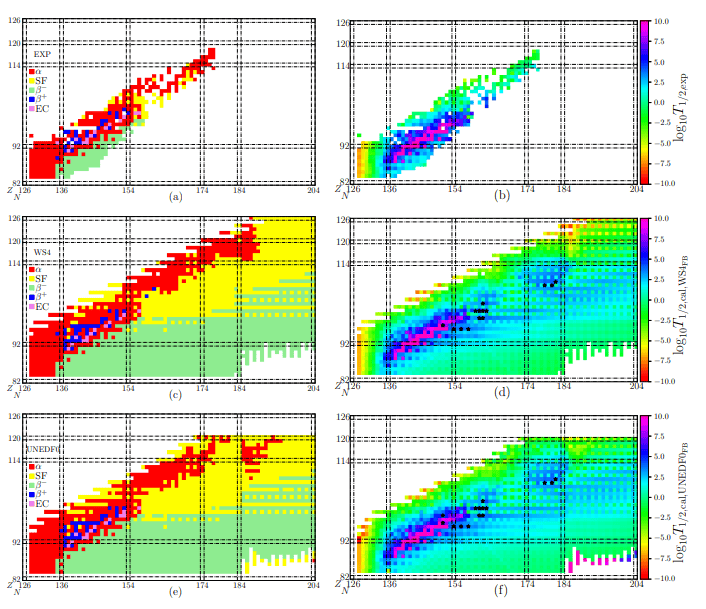
Credit: Nuclear Science and Techniques
Dominant decay mode (left panels) and minimum partial half-lives (right panels) of the α decay, β − decay, β + decay, EC, and SF. (a,b) Experimental data in NUBASE2020. (c–f) The results predicted through RF; WS4 and UNEDF0 denote the sources of predicted energies. Specifically, the FB is used to replace the decay energy to learn SF. The nuclides, for which the predicted partial half-life is longer than 104 s, are marked by a star.
The study of superheavy nuclei is at the forefront of nuclear physics, probing the boundaries of the nuclear landscape and the quest for new elements. These nuclei, typically unstable and possessing short half-lives, present a complex challenge for scientists trying to identify their decay modes - a crucial step in discovering new elements. Traditional methods have used both microscopic and macroscopic approaches, but the advent of machine learning offers a novel pathway.
A study (https://doi.org/10.1007/s41365-023-01354-5) is published in the journal of Nuclear Science and Techniques, researchers from Sun Yat-sen University, have achieved a significant breakthrough in understanding the decay processes of superheavy nuclei. Their pioneering study, employing a random forest machine learning algorithm, offers novel insights into the decay modes and half-lives of elements beyond oganesson (element 118).
In this pioneering research, the team focused on nuclei with a proton number (Z) of 84 or higher and a neutron number (N) of 128 or more, employing semi-empirical formulas to calculate partial half-lives for various decay modes such as alpha decay, beta-minus decay, beta-plus decay, electron capture, and spontaneous fission (SF). The precision of these calculations was significantly enhanced by applying the random forest algorithm, an advanced machine learning technique that integrates a variety of nuclear properties and decay energies. This methodology led to innovative findings in nuclear physics, notably the dominance of alpha decay in neutron-deficient regions and beta-minus decay in neutron-rich areas. The algorithm's accuracy was remarkable, correctly predicting the dominant decay mode in 96.9% of the studied nuclei, and it also revealed the existence of a long-lived spontaneous fission island southwest of element 298 Fl (flerovium), highlighting the complex interplay between fission barrier and Coulomb repulsion in superheavy elements.
This research marks a significant leap in understanding superheavy nuclei, particularly in predicting their decay modes. The insights gained are crucial for the exploration of new elements and the elusive 'island of stability' in the superheavy region. The study also underscores the importance of more accurate measurements of nuclear mass and decay energy for refining predictions. The team has suggested several isotopes for future measurement, which will be instrumental in advancing nuclear research, especially in new facilities like CAFE2 and SHANS2 in Lanzhou.
In summary, the innovative application of the random forest algorithm has opened new doors in nuclear physics, offering a more precise and comprehensive understanding of the decay processes of superheavy nuclei, and paving the way for future discoveries in this exciting field.
More information
Cai, BS., Yuan, CX. Random forest-based prediction of decay modes and half-lives of superheavy nuclei. NUCL SCI TECH 34, 204 (2023). https://doi.org/10.1007/s41365-023-01354-5
Funding information
This work was supported by the Guangdong Major Project of Basic and Applied Basic Research (2021B0301030006).


